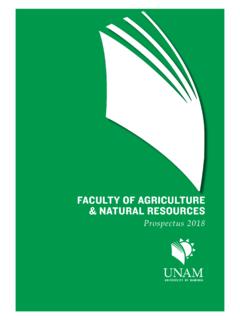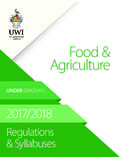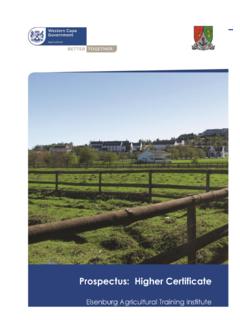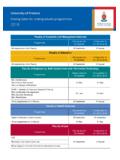Transcription of GOOD AGRICULTURAL PRACTICES FOR OIL PALM …
1 THAI AGRICULTURAL STANDARD TAS 5904-2010 good AGRICULTURAL PRACTICES FOR OIL PALM National Bureau of AGRICULTURAL Commodity and Food Standards Ministry of Agriculture and Cooperatives ICS ISBN 978-974-403-548-6 THAI AGRICULTURAL STANDARD TAS 5904-2010 good AGRICULTURAL PRACTICES FOR OIL PALM National Bureau of AGRICULTURAL Commodity and Food Standards Ministry of Agriculture and Cooperatives 50 Phaholyothin Road, Ladyao, Chatuchak, Bangkok 10900 Telephone (662) 561 2277 Published in the Royal Gazette Section 147D, dated 21 December (3)Technical Committee on the Elaboration of Thai AGRICULTURAL Standards on good AGRICULTURAL PRACTICES for Oil Palm 1. Mr. Chai Korawis Chairperson Oil Palm Expert 2. Mrs. Porntip Jeepjong Member Department of Internal Trade of Thailand 3.
2 Mr. Saksin Chotisakul Member Department of AGRICULTURAL Extension 4. Ms. Nalintip Peanee Member National Bureau of AGRICULTURAL Commodity and Food Standards 5. Mr. Chaiwat Tajurainan Member Petroleum Authority of Thailand 6. Ms. Ornrut Wongsri Member Suratthani Oil Palm Research Center, Department of Agriculture 7. Mr. Teerapong Juntaraniyom Member Oil Palm Research and Development Center, Faculty of Natural Resources, Prince of Songkla University 8. Mr. Wanchai Chanprasert Member Department of Agronomy, Faculty of Agriculture, Kasetsart University 9. Mr.
3 Walratep Punturaumporn Member Thai Chamber of Commerce & Board of Trade of Thailand 10. Mrs. Wiwan Boonyaprateeprat Member Thai Oil Palm and Palm Oil Association 11. Mrs. Orawan Kaewprakaisangkul Member Verification and Laboratory Analysis Association 12. Mr. Bamrung Nooduang Member Oil Palm Grower 13. Mr. Luecha Unyuang Member Oil Palm Grower 14. Mr. Surakitti Srikul Member Oil Palm Expert 15.
4 Ms. Korwadee Phonkliang Member and Secretary National Bureau of AGRICULTURAL Commodity and Food Standards (3)Oil palm is one of the potential tree crops grown in Thailand and oil palm bunches can be used as raw material in the process of palm oil production as a form of safe edible vegetable oil used in many food and non-food products. The AGRICULTURAL Standards Committee deems it necessary to establish the standard for good AGRICULTURAL PRACTICES for Oil Palm to be used as guidance to oil palm growers. This standard is based on the information of the following documents: National Bureau of AGRICULTURAL Commodity and Food Standards 2546. Thai AGRICULTURAL Standard (TAS 9001-2552). good AGRICULTURAL PRACTICES for Food Crops. National Bureau of AGRICULTURAL Commodity and Food Standards 2552.
5 Thai AGRICULTURAL Standard (TAS 5702-2552). Oil Palm Bunch. Department of Agriculture. 2547. Oil Palm Technical Paper. Department of Agriculture. No publication date. good AGRICULTURAL PRACTICES for Oil Palm NOTIFICATION OF MINISTRY OF AGRICULTURE AND COOPERATIVES SUBJECT: THAI AGRICULTURAL STANDARD: good AGRICULTURAL PRACTICE FOR OIL PALM UNDER THE AGRICULTURAL STANDARDS ACT 2551 (2008) ---------------------------------------- --------------- Whereas the AGRICULTURAL Standards Committee deems it necessary to establish an AGRICULTURAL standard on good AGRICULTURAL Practice for Oil Palm in Accordance with the AGRICULTURAL Standards Act 2551 (2008) to promote such AGRICULTURAL commodity standard to meet its quality standard and safety. By virtue of Section 5, Section 15 and Section 16 of the AGRICULTURAL Standards Act 2551 (2008), the Minister of Agriculture and Cooperatives hereby issues this Notification on Establishment of AGRICULTURAL Standards: good AGRICULTURAL Practice for Oil Palm (TAS 5904-2010) established as voluntary standard, details of which are attached herewith.
6 Notified on 4 October 2553 (2010) Mr. Theera Wongsamut Minister of Agriculture and Cooperatives TAS 5904-2010 THAI AGRICULTURAL STANDARD good AGRICULTURAL PRACTICES FOR OIL PALM 1 SCOPE This AGRICULTURAL standard establishes good PRACTICES for the oil palm production. It provides detailed guidance covering from field operation in the plantation to transportation of oil palm bunches to the collection center (ramp) or mill in order to increase production efficiency and to ensure good quality and safe raw material of oil palm bunches or fresh fruit bunches (FFB) suitable for palm oil production as well as taking into account the environmental impact and occupational health and safety of the workers. This AGRICULTURAL standard shall be jointly implemented with TAS 5702-2553, Thai AGRICULTURAL Standard for Oil Palm Bunch.
7 2 DEFINITIONS For the purpose of this standard: Oil palm means tree crop with the scientific name of Elaeis guineensis Jacq. that produces fruit bunches by hybrid of Tenera for commercial purpose. Fertilizer means organic material, synthetic organic material, inorganic or microorganism no matter of its being natural formation or processing for uses as plant nutrients by any means of production methods or causing any chemical, physical or biological changes in soil conditions to have value in promoting plant growth. Hazardous substance means chemical or other substance including chemical product, microorganism and toxin excreted by microorganism that may be harmful to human, animal, plant, properties or environment. Pesticide means any hazardous substance used in agriculture regulated by the Department of Agriculture in accordance with the Ministry of Industry notification referred to as types and lists of hazardous substance promulgated under the Hazardous Substances Act 2535 (1992) and its amendments.
8 Pest means living organism such as disease, insect, animal and weed that is damaging to plant. 3 REQUIREMENTS AND INSPECTION METHODS Requirements and inspection methods shall be as Table 1. TAS 5904-2010 2 Table 1. Requirements and Inspection Methods (Section 3) Items Requirements Inspection Methods 1. Water Source 1. Water source used on farm shall be located in an area safe from contamination of hazardous substances 1. Visual inspection of the environmental setting, in case where there is risk involved, the quality of water shall be tested. 2. Planting Area 2. Planting area shall not pose any excessive risk of hazardous substance that could cause undesirable residue or contamination to the produce over the tolerance level promulgated by relevant laws and regulations 2.
9 Visual inspection of the environmental setting, in case where there is risk involved, the quality of soil shall be tested. 3. The Use of Pesticide 3. In case where pesticide is used, follow the recommendations or refer to the instruction manual of the Department of Agriculture, Ministry of Agriculture and Cooperatives or use accordingly to the recommendations given on the label of product registered with the Department of Agriculture Inspect place of pesticide storage Check record information on pest survey and use of pesticide In case where there is evidence to believe that the use of pesticide is not led to adhered recommendations, sample fruits for residue analysis. 4. Pre-harvest Quality Management Variety Preparation Oil palm seed or seedling shall meet quality requirements of the variety and come from the reliable supply source registered with the Department of Agriculture.
10 Ministry of Agriculture and Cooperatives Check record on sources of oil palm supply Planting Design appropriate lining and spacing for planting to the area and variety Visual inspection of oil palm field plot TAS 5904-2010 3 Items Requirements Inspection Methods Manage oil palm plantation properly Visual inspection of plantation setting and vegetative development of oil palm health Visual inspection of produce and/or check record on harvesting of oil palm bunches Survey the infestation of pests, rats, leaf eating caterpillars, rose beetles, rhinoceros beetles and other pests in the field plot regularly Check record on pest survey Apply appropriate methods to control pests when the level of economic threshold is reached.
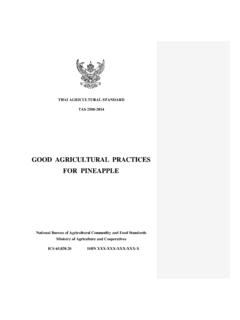
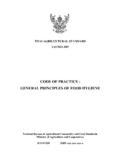
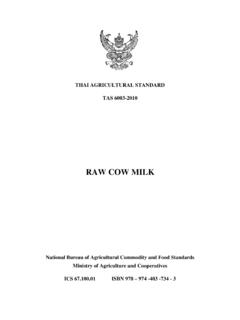
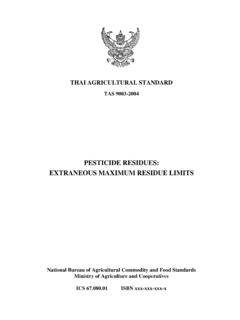
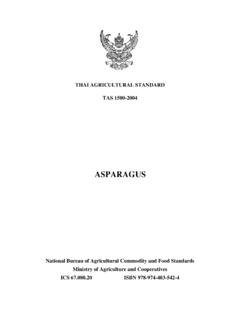
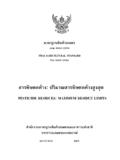
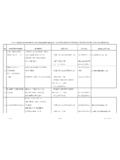
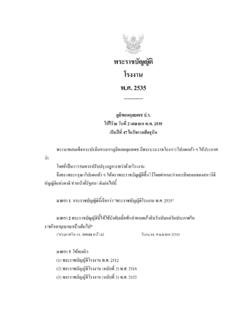


![2007 Natural and Agricultural Sciences] Part 2 ...](/cache/preview/1/5/6/8/8/a/b/9/thumb-15688ab9cc4402ef9b2339ad72a47048.jpg)
